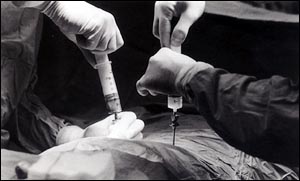
Imagine the despair of leukemia patients who cannot find a matching bone marrow donor among relatives or in any of the computerized registries. A Weizmann Institute technique for using mismatched tissue may one day assure a donor for virtually every candidate for a bone marrow transplant and put an end to their agonizing search.
A bone marrow transplant is a last-ditch effort undertaken only after all other means of combating the leukemia have been tried. That's because it is inherently fraught with danger. Patients may die from the radiation or the chemotherapy used to kill off the cancer and to disarm their own immune system so that it doesn't attack the transplant. They may succumb to infections during the period after their immune system has been knocked out and before the new marrow takes root. In cases of partially matched marrow, there is the danger of graft-versus-host disease, in which the foreign white cells attack the patient's own tissue. Or the transplant may fail because residual white cells in the patients system simply overcome the transplanted ones before they can confer healthy immunity.
A potential solution to these life-threatening problems is emerging from the work of Prof. Yair Reisner of the Institute's Immunology Department. A decade ago, Reisner, then working at the Memorial Sloan-Kettering Cancer Center and using a technique he developed with Weizmann Institute's Prof. Nathan Sharon, helped solve the problem of conferring immunity on 'bubble children.' These youngsters are born without immune systems and cannot survive outside the protective confines of large plastic bubbles. Before transplanting the bone marrow, Reisner first treated it with lectin, a soybean derivative. The lectin neutralized aggressive white cells in the donor marrow that can cause graft-versus-host disease. Once cleansed of these cells, marrow stem cells could be implanted in the young patients with no fear of rejection, since the children had no immune systems to act against the transplanted tissue. The donated stem cells proliferated, creating the immunity that had been lacking.
Recently, Reisner developed this technique further so that it can be applied to leukemia patients. First, donated stem cells are cleansed with the soybean lectin to erase the characteristics that are the source of trouble in mismatched tissue. This makes it possible to use marrow from non-matching donors. Then, the number of stem cells taken from the donor is greatly increased so that the sheer volume of implanted cells overwhelms any resistance mounted by residual white cells in the recipient.
To increase the quantity of stem cells, Reisner, working with Prof. Massimo Martelli of Italy's Perugia University, decided to try an approach used originally to isolate stem cells from cancer patients. It consists of treating the donor with hormone injections for a week prior to harvesting. This releases large numbers of stem cells into the bloodstream. In a procedure called leukapheresis, blood is then taken and passed through a machine that extracts the stem cells. The rest of the blood is then returned to the donor. The extracted stem cells are cleansed of white blood cells and readied for transplant.
Since 1993, some 100 patients have been treated in Perugia with the Institute-derived method. The current survival rate is almost 50 percent, similar to that obtained with perfectly matched transplants. The donor marrow comes from one of the patients relatives. Since the tissue need be only partially matched, a suitable donor can nearly always be found among family members. Several hospitals in Israel, Germany and the United States have begun to introduce the new method.
Reisner is now pursuing research to reduce the amount of radiation that bone marrow transplant candidates receive in preparation for the procedure, a factor that has limited its use to cancer patients. If successful, his research may make bone marrow transplants a viable treatment option for people with such disorders as thalassemia, sickle-cell anemia and Gaucher's disease. Reisner's work may also allow physicians to transplant organs and tissues other than bone marrow from mismatched donors.
Prof. Reisner will soon be appointed to the Henry H. Drake Professorial Chair in Immunology. This research was funded in part by Rowland Schaefer, Miami, Florida; the Pauline Fried Estate, Los Angeles, California; the Concern Foundation, Los Angeles, California; and the Israel Academy of Sciences and Humanities. Research facilities: Mr. and Mrs. Sanford Diller, Los Angeles, California.
